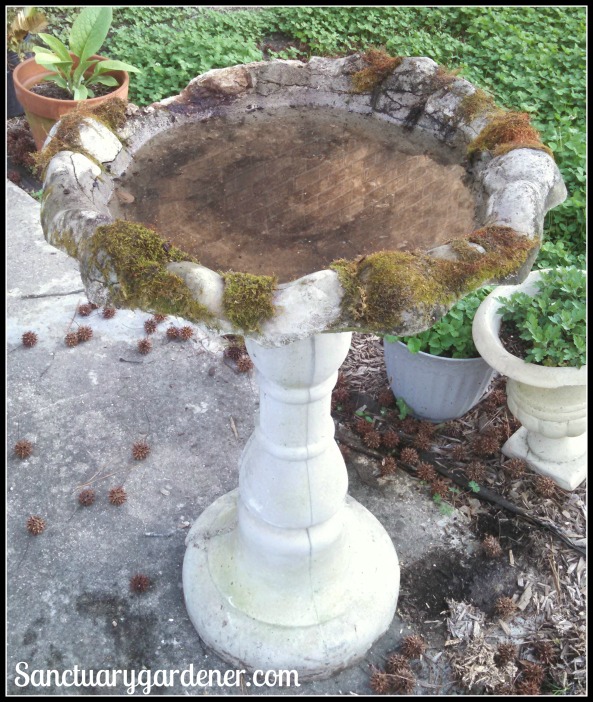 There’s not a gardener or homesteader – that I know of – that doesn’t want to attract birds, butterflies, and beneficial insects to his or her garden or backyard. What most people think of when they want to attract these creatures is planting attractive flowers, building bird houses, and putting up bird feeders. All of those are great ideas – and needed – if you want birds, butterflies, and beneficial insects. However, many people don’t think about one other necessity: water.
There’s not a gardener or homesteader – that I know of – that doesn’t want to attract birds, butterflies, and beneficial insects to his or her garden or backyard. What most people think of when they want to attract these creatures is planting attractive flowers, building bird houses, and putting up bird feeders. All of those are great ideas – and needed – if you want birds, butterflies, and beneficial insects. However, many people don’t think about one other necessity: water.
BENEFITS OF BIRDBATHS
Birdbaths are not just beautiful focal points in a garden. They also provide necessary water – not only for drinking but also for bathing. Birds need to bathe to remove parasites, enhance the insulation their feathers give them, and add a protective coating of oil as they preen (part of their bathing ritual).
Having water available will draw more birds to your yard – even ones that don’t eat seeds (and thus, wouldn’t be drawn by your bird feeder). Of course, more birds equals more visual pleasure for the gardener. But there’s another benefit to having more birds. There will be more insect-eating going on, which means fewer destructive insects in your garden. And for me here in the South, birds have a veritable smorgasbord in my garden!
Another benefit to having a birdbath is that it will also provide water for beneficial insects – predatory wasps, butterflies, and bees, for example. They need water, too. By putting a few marbles in the center of your birdbath – or something that the insects can stand on and not be covered in water – bees and butterflies will be able to drink while visiting your flowers. Who knows? It may enable them to stay longer (and maybe notify some of their “friends” that your yard is a great place to be).
BIRDBATH REQUIREMENTS
Birdbaths can be made out of any type of material – cement, plastic, metal, etc. However, there are a few things to keep in mind when purchasing (or making) a birdbath.
- The basin should have a shallow slope so that even small birds can easily use it (without having to jump in). Think of a puddle. That’s what you’re aiming for.
- If there are cats or squirrels or other critters around, you may not want to keep the basin on the ground. It’s better if it’s raised two to three feet off the ground. (Cement birdbaths come with pedestals that are just right.)
- If your basin doesn’t have a good ridge around it (or even if it does), you’ll want to put something inside the basin – like sand or a tree branch – to give birds a good footing. (Remember to put marbles in a basin for bees and butterflies.)
- Be sure to add fresh water every two to three days. Birds won’t drink stale water.
- Keep the basin clean. Birds won’t drink dirty water. Before changing the water or refilling the basin, check to be sure it’s clean. Cement basins can be more difficult to clean, but a stiff brush will do. Also, with cement basins, you’ll have to be sure that you clean off any green algae or moss that might grow on it.
- For cold winter gardens, you’ll need a way to keep the water from freezing. (Birds still need water in the winter!) You can purchase a small immersion heater or put a light bulb in a terra cotta pot and set the water basin on top. Another winter note: cement birdbaths could crack in cold weather, so keep that in mind when choosing a birdbath.
- Optional features: A water jiggler (they make solar-powered ones) will keep the water moving, which will prevent mosquitoes from laying eggs in the water and will keep the water fresher. A mister will also cause movement, which attracts birds.
WHERE TO PUT YOUR BIRDBATH
The best spot to put your birdbath is in the shade. It not only will help slow evaporation of the water, but it will also keep the water cooler, especially in the summer. It should also be in an open area so birds can look around for predators. Finally, there should be a tree or bush close by – something for the birds to rest in, scope out the area, then swoop down into the birdbath.
My main birdbath is about six feet from the gum tree that my bird feeder hangs from, and I’ve watched birds swoop right to the birdbath from a tree limb and the bird feeder.
I now have three birdbaths in my yard. You know about two of them. One is old and mossy, and that is for my shade garden. The lighthouse one (above) is my main birdbath, next to the bird feeder. However, I now have a very large one in my front yard.
It needs to be cleaned and filled with water, and I also want to plant flowers around it. (You can see what’s left of my gladioli in the background…plus some weeds. OY!) Being in the front yard, I think this will be more of a decorative piece than a functional one. However, once I get the flowers planted, I may put a bunch of marbles in this one and see what happens.
As you can see, I don’t think a gardener can have too many birdbaths! Do you have any in your garden or backyard?





